Introduction
Part 1, Section 1 of the Anti-social Behaviour, Crime and Policing Act 2014 allows the court to grant an injunction against a person aged 10 or over if two conditions are met. The court must be satisfied, on the balance of probabilities, that the respondent has engaged or threatens to engage in anti-social behaviour.
The court must also consider it is just and convenient to grant the injunction for the purpose of preventing the respondent from engaging in anti-social behaviour.
These cases are in scope for civil funding pursuant to Schedule 1, Part 1, paragraph 36 of the Legal Aid, Sentencing and Punishment of Offenders Act 2012.
Please note, the civil legal services prescribed under Part 1 are subject to exclusions in Parts 2 and 3 of Schedule 1.
In this guidance these injunctions are referred to as ‘ASBI’s’ which is a common abbreviation used in practice.
This guidance has been developed specifically to support providers who are less familiar with the civil legal aid application process.
Funding for ASBI’s is provided as part of civil legal aid.
There are significant differences from criminal legal aid to keep in mind in the application process and when managing the case.
To represent a client in ASBI proceedings you must:
- be authorised to undertake civil legal aid
- apply for a civil legal aid certificate
All applications for civil legal aid must be submitted via the Client and Cost Management System (CCMS) if you hold a 2018 Standard Civil Contract or 2022 Standard Crime Contract.
If you do not hold a 2018 Standard Civil Contract or 2022 Standard Crime Contract, you must email the application to ContactECC@justice.gov.uk.
Applications for civil legal aid from providers not holding a 2018 Standard Civil Contract or 2022 Standard Crime Contract must be accompanied by an application for an Individual Case Contract (ICC). The ICC criteria are set out on page 18 below. Your organisation must hold a Lexcel Legal Practice Quality Mark or a Specialist Quality Mark before we can enter into an Individual Case Contract.
The merits test is central to the application for legal aid. This must be addressed in detail to satisfy the relevant criteria and demonstrate the client’s financial eligibility.
Pre-action work
Schedule 1, Part 1, paragraph 36 of the Legal Aid, Sentencing and Punishment of Offenders Act 2012 provides provision for the funding of legal services in relation to an application in respect of an injunction against the individual under section 1 of the Anti-social Behaviour, Crime and Policing Act 2014. Civil legal aid is not restricted to advocacy services and may therefore be provided in relation to pre-action work.
Closure Orders
The Anti-social Behaviour, Crime and Policing Act 2014 introduced Closure Orders that can be sought on a number of different grounds. Only grounds including criminal behaviour fall within the scope of criminal legal aid, which will include representing the client at court.
Closure orders sought in relation to disorderly or offensive behaviour or serious nuisance which do not relate to criminal behaviour are only in scope for civil legal aid at the Legal Help form of service. As the proceedings take place in the magistrates’ court, advocacy is specifically excluded under Schedule 1, Part 3 of the Legal Aid, Sentencing and Punishment of Offenders Act 2012, and therefore to be represented at court, the client will have to make an application for Exceptional Case Funding (ECF).
The application process for ECF differs to the steps contained within this guidance. More information on how to make an ECF application can be accessed online.
Queries in respect of making an ECF application should be sent to associatedcivilapplications@justice.gov.uk.
Breaches
All work relating to breaches of a Part 1 Civil Injunction will be classed as criminal for the purposes of legal aid. Accordingly, you must apply for criminal legal aid to provide advice and assistance in relation to such matters.
Information on legal aid for breaches of injunctions made under Part 1 of the Anti-Social Behaviour, Crime and Policing Act 2014 can be accessed online.
Providers holding a 2022 Standard Crime Contract
Getting setup on CCMS
Registering a user and granting access to CCMS
This guide provides the step-by-step process for creating a new user and giving them access to CCMS. Please note, this can only be done by a user with the CCMS Firm Administrator role.
Granting CCMS access to an existing user
If you already have an LAA Online account, for example, because you submit criminal applications or use CWA, our Online Support Team can amend your account and provide you with access to CCMS.
Email online-support@justice.gov.uk
Telephone 0300 200 2020
You can also use our webchat service.
Before contacting the Online Support Team, you will need to have obtained authorisation from your Contract Manager or firm’s director via email.
The following guide outlines how your CCMS Firm Administrator can do this on your behalf.
Registering a user and granting access to CCMS – no CCMS Firm Administrator
If you do not have a CCMS Firm Administrator, for example, because they have left employment, the Online Support Team will be able to assist you with creating a LAA Online Account. You will also need to have obtained authorisation from your Contract Manager or firm’s director via email.
We will email your login details once an account has been created, at which point you will be able to assign permissions to CCMS.
Check the appropriate CCMS roles and responsibilities have been assigned once an account has been created.
Starting an application
Once your user account has been created, visit the LAA Online Account and select Client and Cost Management System.
From the home screen select ‘New Application’.
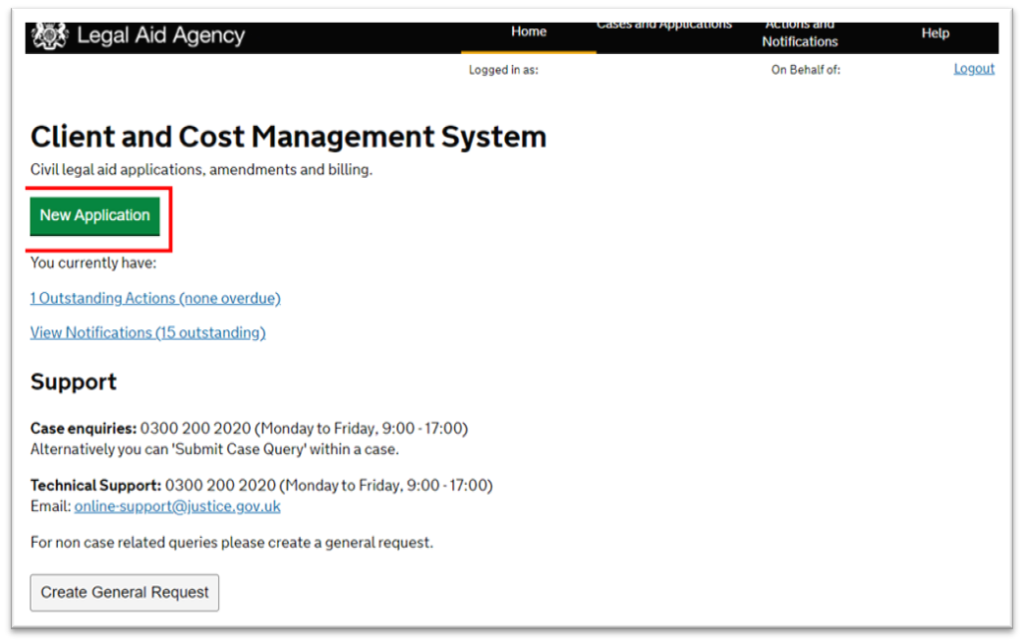
Select your office from the drop-down menu and press ‘Next’.
Select ‘Crime Civil’ as the Category of Law and press ‘Next’.
You will need to decide whether to make an Emergency or Substantive Application for legal aid.
Emergency Representation
Applications for emergency representation must satisfy the interests of justice test. Further information is available at paragraphs 7.28 – 7.30 Lord Chancellor’s Guidance under Section 4 of the Legal Aid, Sentencing and Punishment of Offenders Act 2012.
- Emergency civil legal aid certificates are limited to the urgent necessary steps in the proceedings. They cannot be extended beyond an 8-week time limitation.
- If you apply for emergency representation and receive an emergency civil legal aid certificate you will need to make a Substantive Amendment for a full certificate. This is a requirement even where the work is concluded within the scope of emergency representation.
- Delegated Functions is a function of the Director or the Lord Chancellor delegated to you by an Authorisation. This means you can make determinations for legal aid when making an emergency application. Granting an application under Delegated Functions enables you to work immediately under the terms of an emergency certificate.
- If you make an emergency application without exercising Delegated Functions, you will need to await a determination by the LAA before incurring costs.
Select whether you have used Delegated Functions and press ‘Next’.
You will need to complete a Client Search to check if your client is registered within the LAA system. Mandatory fields are your client’s first name, surname at birth and date of birth. You may also include a unique identifier in the search, for example, your client’s National Insurance Number.
Once the fields have been completed press Search.
If the search returns no results you will need to select ‘Register New Client’. You will be presented with a privacy notice on the next screen. Tick the box to confirm your client or their representative has read and agreed to the privacy notice and press ‘Next’.
You will need to enter Basic Client Details. The mandatory fields are Title, Surname, Country of Origin and Marital Status. Select ‘Next’ once entered.
You will need to enter Client Contact Details. The mandatory fields are at least one contact telephone number, password/password reminder, and correspondence method. We will use the password information to verify your client’s identity if they contact us. Select ‘Next’ once details have been entered.
You will need to provide Client Address Details. You may tick the box if your client is of no fixed abode. Once details have been entered select ‘Next’.
You will need to enter Equal Opportunities Monitoring information. This includes an option to provide details of any special requirements your client may have. Select ‘Next’ once details have been entered.
You will be taken to the Summary of Client Information screen. You should review the information provided and edit details if necessary. Select ‘Submit Client’ once the information has been checked.
At the Submission Confirmation screen select ‘Next’ to start completion of the application.
Completing the application sections
You will be presented with the Application Summary screen.
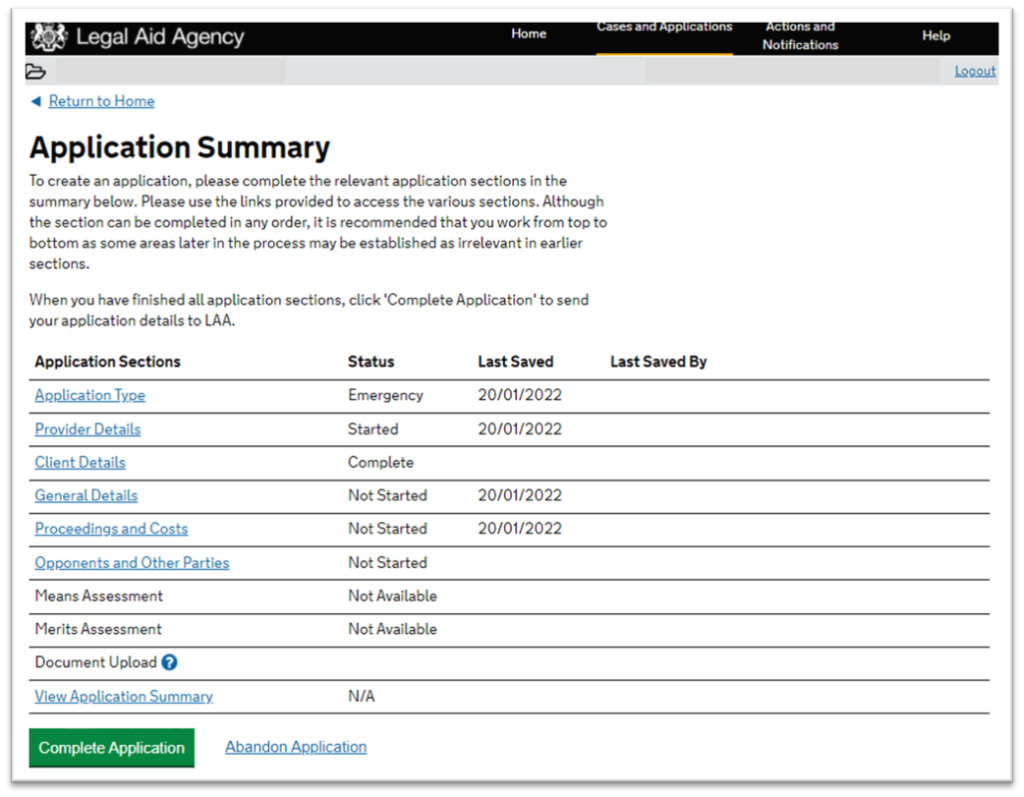
The application type and client details have already been completed based on the information supplied. The remaining sections will need to be completed before the application can be submitted.
Select Provider Details to supply the fee earner’s details and the Contact Name for the application. Once the details have been completed select ‘Confirm’.
The Application Summary screen will now be updated to show a Complete status against Provider Details.
Select General Details to complete the next section of the application. You will be asked to confirm the Correspondence Address details for your client. Select Next once details have been entered.
You will be taken to the Linked Cases Summary screen. You will be able to link this application to other cases if you represent other parties within the same proceedings.
Please refer to Linking Cases for more information on linking cases.
If you do not wish to link the application to other cases, select ‘Confirm’.
The Application Summary screen will now be updated to show a Complete status against General Details.
Select Proceedings and Costs to complete the next section of the application.
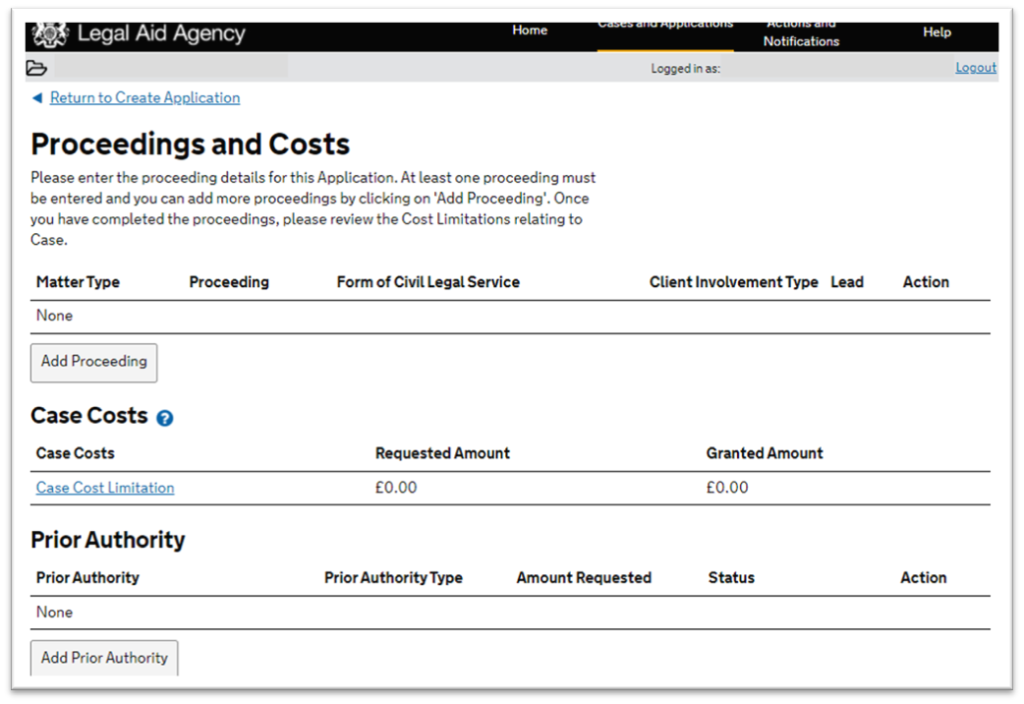
Select ‘Add Proceeding’. From the Matter Type drop-down menu select Crime Civil and select ‘Next’.
From the Proceeding drop-down menu select Part 1 Injunction ASBCPA – Crime Civil and select ‘Next’.
Select Defendant/Respondent as the Client Involvement and Full Representation as the Form of Civil Legal Service. Select ‘Next’.
You will need to insert a Scope Limitation. You can change the default scope limitation by clicking the ‘Add Scope Limitation’ button.
Select ‘Next’ to confirm the Scope Limitation details.
Select Opponents and Other Parties. Select ‘Add Organisation’ and complete the details to perform a search. If your search returns a match you can select ‘Use this record’ to add the organisation as the opponent.
Alternatively, you may select the option Create New Organisation. Once you have selected the opponent you will need to provide details of their relationship to the case and your client from the 2 drop-down menus. Select ‘Confirm’ once completed.
If you do not need to add any further Opponents and Other Parties, select ‘Return to Create Application’.
Means and Merits Assessments
The Means Assessment and Merits Assessment options are now available for completion.

Please refer to the Means Assessment Information for guidance on completing the Means Assessment.
Next you will need to complete the Merits Assessment. CCMS will ask questions regarding the merits of the case.
If you have created an Emergency Application, select the option that you are making an urgent application. You will be asked to provide brief details of the urgency, and once this is completed, select ‘Next’.
You will be asked why delegated functions have not been used if this was not selected. Select ‘Next’ once this field has been completed.
You will be asked to provide Emergency Details. Select the reason for urgency from the list of options and click ‘Next’ once the fields have been completed.
You will be asked whether your client has previously received legal aid and the reasons why your client is applying for representation. Select ‘Next’ once completed.
You will be asked to provide General Details about the case, including the date your client first visited your firm, the main purpose of the application and the number of clients you are representing in the proceedings. Select ‘Next’ once completed.
You will be asked whether proceedings are currently before the court. If proceedings have been issued answer ‘Yes’ and complete the fields. Select ‘Next’ once complete.
You will be asked if the case has been listed for a final contested hearing. Select ‘Next’ once complete.
You will be asked if the client requires separate representation from other parties in the proceedings. Select ‘Next’ once complete.
You will be asked a series of questions to help CCMS route the application to the appropriate team at the LAA.
This includes:
- likelihood of costs exceeding £25,000
- whether the proceedings relate to the client’s capacity
- whether it’s a multi-party action
- whether the client has full or partial UK status
Select ‘Next’ once complete.
You will be asked to provide details of alternative funding. This includes answering questions about whether other persons might benefit from the proceedings who can reasonably be expected to fund the case. You will also need to answer questions about any insurance policies held by the client. You will be prompted to provide specific answers to questions about After the Event Insurance (AFE) and Conditional Fee Arrangements CFA). You should complete both boxes explaining the proceedings are unsuitable for AFE and CFA. Select ‘Next’ once complete.
You will be asked questions about any attempts which have been made to settle the matter. You will be prompted to provide specific answers if attempts to settle have not been made, which should be answered with an explanation that your client is the respondent in proceedings. Select ‘Next’ once complete.
You will be asked to provide information about your client’s likely prospects of success. Select ‘Next’ once complete.
Prospects of success
Prospects of success means the likelihood that your client will obtain a successful outcome at trial or other final hearing.
Successful outcome means the outcome a reasonable individual would intend to achieve in the proceedings in all the circumstances of the case.
For further information on assessing prospects of success refer to Regulations 4 and 5 of the Civil Legal Aid (Merits Criteria) Regulations 2013 and paragraph 4.1 Lord Chancellor’s Guidance Under Section 4 of LASPO 2012.
You will be asked to provide details of your estimated costs to trial (excluding VAT). Select ‘Next’ once all questions have been answered.
You will be asked to confirm why this matter is considered proportionate for the purposes of the regulations. Select ‘Next’ once details have been provided.
You will need to assess whether the case is of overwhelming importance to your client, for example, if the case concerns life, liberty or physical safety. You will also need to confirm if you are contending that the case has human right elements. If so, you will need to provide details of the articles your client will rely upon. Select Next once complete.
You will need to provide your client’s statement of case. You can either complete the statement of case fields or upload an attachment on the next screen.
Statement of case
Applications for civil legal aid must satisfy the requirements set out in the Civil Legal Aid (Merits Criteria) Regulations 2013. In particular, if applying for full representation, you will need to satisfy Regulations 39, 41, 42 and 43. If you are applying for Investigative Representation, Regulation 40 will need to be satisfied. The application for civil legal aid is merits tested, and your statement of case must provide sufficient information to demonstrate those requirements are met.
Regard should be given to Regulation 7, which defines the cost-benefit test applied at Regulation 42.
Applications for civil legal aid in anti-social behaviour injunction proceedings will need to satisfy the ‘reasonable private paying individual’ test. You will need to show that the potential benefit to be gained from the provision of civil legal services justifies the likely costs, such that a reasonable private paying individual would be prepared to continue the proceedings having regard to the prospects of success and all the other circumstances of the case.
The statement of case will need to provide details of what your client is trying to achieve and a reasoned argument as to the prospects of achieving that aim. This should include details of your client’s response to the allegations.
You can access the Civil Legal Aid (Merits) Regulations for further information.
Once you have provided your client’s statement of case you will be asked whether you would like to provide additional supporting documents. We will require a full copy of the pleadings, which should include any witness statements. You should upload your client’s statement in response to the allegations if one has been filed.
You will be asked to provide confirmation that your client will sign the relevant declaration before submission of the application. There is space to explain if the declaration will not be obtained before submission. You will also be asked to confirm that you have explained the implications of the certificate being revoked to your client.
Revocation may occur if your client fails to comply with requests for information on the assessment of this financial eligibility. If funding is revoked, they will become liable for any costs incurred under the emergency civil legal aid certificate.
You will be taken to the Merits Declaration page. Tick the box to confirm the client, or their representative, has read and understood the declaration. Select Complete in the next screen.
You will be presented with an Assessment Summary. Check the details provided are accurate and select Confirm.
Once the Means and Merits Assessments have been completed you can select the option ‘Document Upload’.
CCMS will display details of the documents you need to provide based on the information supplied. You will see Yes/No options for each item, allowing you to indicate whether you wish to upload the documents with the submission of your application. Once ‘Yes’ is selected you will be presented with the ability to select files from your computer. You will need to indicate which document is being uploaded from the Document Type drop-down list. There is also an option to provide a Document Description.
You do not have to upload documents at this point. If the application is submitted without documents, we will send you a notification to supply them separately.
Please note, we will be unable to consider your application for legal aid until the documents have been provided.
Please refer to the online guidance if you require further support on Submitting Electronic Evidence: Submitting documents electronically.

Except for Application Type, each of the Application Sections should now show a Complete status.

Select Complete Application, which will take you to the Application Summary screen. Review the details provided and select Back at the bottom of the screen if you identify any entries which need amending. If the details provided are correct you should select the Print option to access a copy of the Application Summary. Your client will be required to sign the printed version of the summary, which should be retained on file for auditing purposes.

Select ‘Next’ once you have printed a copy of the Application Summary. You will need to tick the box to confirm you have obtained the necessary signed declaration from your client for retention on the client’s file. Select Continue to complete the submission of your client’s application for funding.
Managing live cases
The Legal Aid Agency (LAA) will issue a funding certificate if the relevant merits and financial eligibility criteria are satisfied. Funding certificates are effective from the date of issue.
The funding certificate will specify the proceeding for which funding can be provided to your client. It will also contain scope and costs limitations, which differs from funding issued in criminal proceedings.
The scope limitation specifies the point in the proceedings within which you are authorised to represent your client. Once that limitation has been reached you must to seek an extension to the scope of the certificate to continue providing representation.
Costs limitations work similarly. The default costs limitation is £2,250 excluding VAT. This covers profit costs, disbursements and counsel fees. You will need to apply for an amendment to increase the cost limitation. Amendment requests to increase costs limitations should include details of the costs incurred to date and an explanation of how future additional costs have been calculated.
Guidance on how to submit amendments using CCMS can be located online.
Solicitors without a legal aid contract
Solicitors who do not hold a legal aid contract will be unable to use CCMS. Instead you will need to complete the CIV APP 1: application for civil legal aid certificate form. You will also need to provide the relevant civil means assessment form.
Civil legal aid application forms:
- CIV APP 1 – the application for legal aid must be made using this form
- CIV MEANS1 – should accompany the CIV APP 1 if your client does not receive a passported benefit
- CIV MEANS 2 – should accompany the CIV APP 1 if your client receives a passported benefit
- CIV MEANS 4 – should accompany the CIV APP 1 if your client is under 16 years of age
All civil legal aid application forms are accessible online.
CIV APP 1: application for civil legal aid certificate form
| Page 1 | Provide your client’s details. |
| Page 2 | Equal Opportunities and Disability information is optional. |
| Page 3 | Provide your contact details and information about previous legal aid received by your client. |
| Page 4 | Confirm client involvement and the proceedings within which your client requires representation. Tick ‘Full Representation’. |
| Page 5 | Provide information on your client’s prospects of success. see page 11 for more information on prospects of success. |
| Page 6 | Provide details of your estimated costs. |
| Page 7 | Provide the opponent and other interested parties’ details. |
| Page 8 | Provide details about suitability for Conditional Fee Agreements and Before the Event Insurance. |
| Page 9 | Provide details of alternatives to litigation. |
| Page 10 | Statement of Case. You may attach the statement of case as a separate document. See page 11 for more information on the statement of case. |
| Page 11 | Complete page 11 if you believe the case includes a ‘significant wider public interest’ or if you are contending the case has ‘overwhelming importance to the individual’. Reference should be made to the Civil Legal Aid (Merits Criteria) Regulations 2013. |
| Page 12 | You do not have authorisation to grant funding under delegated. |
| Page 17 | Provide authorised litigator and client signatures. |
NOTE: Further information about Individual Case Contracts can be found on page 18.
Email completed forms to ContactECC@justice.gov.uk.
Applying for an individual case contract
If you do not hold a 2018 Standard Civil Contract or 2022 Standard Crime Contract you will need to make an application for an Individual Case Contract. This does not apply if you only hold a 2022 Standard Crime Contract, because injunctions brought under Part 1, Section 1 of the Anti-social Behaviour, Crime and Policing Act 2014 fall within the category definition of ‘associated civil work’. There is no prescribed application form, but the relevant request will need to be included either within your statement of case or as a separately attached document.
You will not need to apply for an Individual Case Contract if you hold a 2018 Standard Civil Contract, as this work falls within the definition of ‘miscellaneous work’. Information on Matter Starts is contained at paragraph 2.30 of the 2019 Standard Civil Contract specification, which will apply should you open the case under Legal Help.
The criteria for Individual Case Contracts are contained within Regulation 31(5) Civil Legal Aid (Procedure) Regulations 2012.
The effective administration of justice test will be satisfied if the Director of Legal Aid Casework decides that it is necessary for a provider to provide the services which are the subject of the application under an individual case contract, having considered –
- the provider’s knowledge of the particular proceedings or dispute and expertise in providing the civil legal services which are the subject of the application;
- the nature and likely length of the particular proceedings or dispute;
- the complexity of the issues; and
- the circumstances of the individual making the application
NOTE: Your organisation must have either a Lexcel Legal Practice Quality Mark or a Specialist Quality Mark before we can enter into an Individual Case Contract.
If we do not consider that the requirements for an individual case contract are met, even if the application meets the other necessary tests, we will contact you to inform you. There is no right of appeal. In these circumstances the applicant will need to instruct a contracted firm or a non-contracted firm that can meet the requirements.
Providers holding a 2018 Standard Civil Contract
The process of applying for legal aid mainly mirrors the steps on pages 5 to 15 of this guide.
There are two key differences which should be noted:
- When selecting the ‘Category of Law’ during the initial application setup, select ‘Residual’ from the drop-down menu (see page 5).
- When adding the proceeding to the application, select ‘Nuisance’ as the Matter Type and Part 1 Injunction ASBCPA – Nuisance as the proceeding from the drop-down menus (see page 8).
Claiming costs
How and when to claim interim payments on account (POAs) on CCMS
During the lifetime of a case, both solicitors and counsel are entitled to claim interim payments for costs for either third-party fees, such as experts, or their current running costs to date.
POAs are an interim ‘loan’ in effect which will be offset against the final bill. These are not considered a final payment and must be accounted for within your final claim for costs.
POAs can be either a disbursement (for solicitors) or a profit costs POA (for solicitor or counsel) at certain trigger points during a case.
Disbursement POAs can be claimed at any time by the solicitor for 100% of any expert or third-party invoice that requires payment.
Profit Cost POAs are allowed only 3 months after the emergency certificate is issued and then only 4 can be claimed in the following 12-month rolling period. Each claim can be up to 80% of your running costs to date.
Previous Profit Cost claims will be taken into account on any subsequent claims which will mean only 80% of the overall running total will be paid.
NOTE: All POAs paid will be recouped when the final bill is paid. If POAs are not accounted for in your final bill, then this will leave a shortfall for the costs claimed as a POA.
There are CCMS step-by-step guides for each type of POA:
- Payments on account: Profit Costs
- Payments on account: Disbursements
- Counsel payment on account guide
Counsel’s fees
You have 2 options for how and when counsel claim their costs:
- Assign and allocate counsel to CCMS for them to claim directly:
- counsel give you a fee note or estimated costs
- you assign counsel to the case and allocate each a cost limit based on the estimates
- counsel can then claim an interim POA
- when the case concludes, each counsel will receive a CCMS notification to submit their final claim
- we assess solicitor and counsel final bills together
- See Allocate Costs to Counsel guidance.
- Bill on behalf of counsel within your bill
- you must agree this with counsel
- you must upload a signed fee note from counsel confirming they agree for you to bill on their behalf
- we will pay counsel fees to you as part of your bill for you to then pay each counsel
- you do not need to assign or allocate costs to counsel
- counsel cannot claim an interim POA
You may also choose a hybrid approach if multiple counsel are instructed. You can assign and allocate some but bill on behalf of others.
Reporting the case outcome
When the case concludes you need to report the outcome of proceedings.
Use the Outcome task on CCMS to report these details and request the discharge of the funding certificate if it remains ‘Live’.
Date of final work on the case and the relevant Outcomes Codes must be entered in a completed Outcome task which can be found in the ‘Record Outcome’ section of the case on CCMS.
Guidance on Reporting an Outcome and Discharge a certificate is available online.
Where there is a favourable financial outcome for the client you will need to report this as a separate award within the Outcome tasks. This will be if the client has a costs order in their favour or receives any damages which would fall under the Statutory Charge.
A specific guide and training video are available to assist. Look at Reporting a Costs or Damages award within the Outcome task.
As part of the Outcome task, you will need to report any legal help costs incurred in the pre-certificate section.
Finally, you should upload a copy of the final order as evidence or if no final order was made then respond to the document request confirming the same to ensure your Outcome is processed promptly.
NOTE: You cannot submit a final bill without first reporting the outcome of the case.
Submit a final bill to claim payment (solicitor and counsel)
Once an Outcome task has been submitted and you have been notified it has been processed you will have the option to create and submit a Final Bill.
Refer to Table 10(a) rates from Schedule 1 – Remuneration Regulations 2013.
| Activity | Higher courts | County and magistrates’ |
| Routine letters out | £6.75 per item | £5.94 per item |
| Routine telephone calls | £3.74 per call | £3.29 per call |
| Preparation and attendance | £71.55 (London) £67.50 (Non-London) | £63 (London) £59.40 (Non-London) |
| Attendance at court or conference with counsel | £33.30 | £29.25 |
| Advocacy | £67.50 | £59.40 |
| Travelling and waiting | £29.93 | £26.28 |
Counsel should refer to Table 1 rates from Schedule 2 – Remuneration Regulations 2013.
| Activity | Higher courts | County and magistrates’ |
| Preparation and attendance | £71.55 (London) £67.50 (Non-London) | £63 (London) £59.40 (Non-London) |
| Attendance at court or conference with counsel | £33.30 | £29.25 |
| Advocacy | £67.50 | £59.40 |
| Travelling and waiting | £29.93 | £26.28 |
To create a final bill on CCMS refer to the submitting an LAA assessed bill guidance online.
You can access the Civil Finance Electronic Handbook online too.
Step 1
Ensure you have the option for ‘Solicitor Final’. If you do not, check the Outcome task has been submitted for every proceeding on the certificate.

Step 2
Follow the questions through, answering if the client has a financial interest (such as paying contributions, revoked certificate, and financial recovery) and if the bill has been court assessed.
You will then reach the below question. You should indicate ‘Yes’ where you are billing on behalf of any counsel in the second question and ‘Yes’ to the first question if you have any disbursements to claim.

Step 3
Enter the court type where proceedings concluded and if there are multiple courts involved. You will reach the below screen for Non-Family Billing for Solicitor work only.


You should enter each line of work undertaken from your file such as 1 hour of attendance on the client, clicking ‘Add’ after each one.
CCMS will generate the correct rate from the rules base, therefore you only need to confirm either the hourly rate, enhancement and VAT or the number of items (such as letters), enhancement, and VAT.
When all work has been completed for the solicitor you can click Next which will then move on to billing on behalf of counsel.
Step 4
Billing on behalf of counsel will initially ask if counsel will be claiming enhancement (only if they are Junior Counsel in the County Court) on their costs. You should reply accordingly and move on to the next screen.
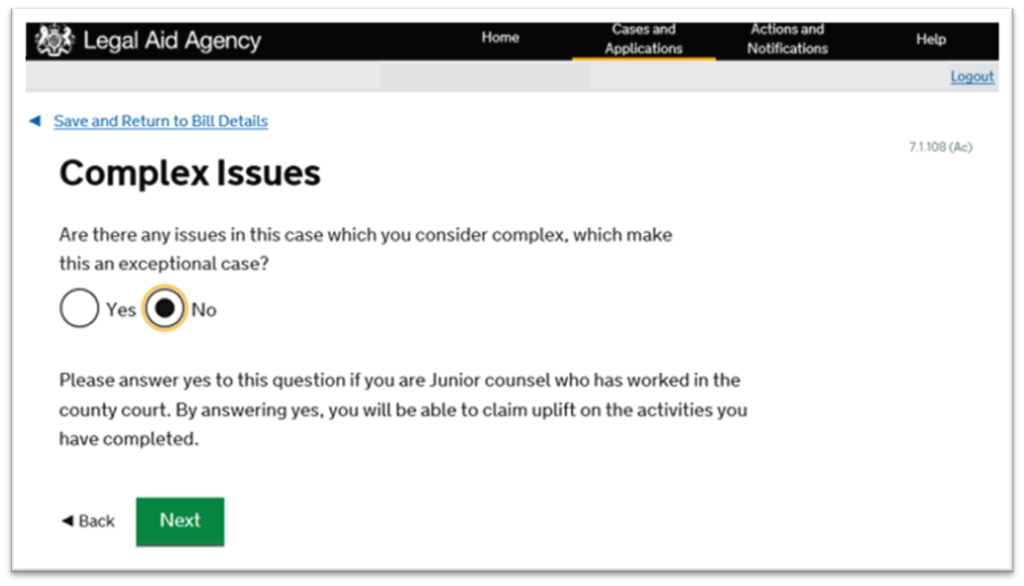
Step 5
Codified Barrister Rates screen. If you are not claiming within the Codified Rates Scheme for counsel, click ‘Remove’ at the bottom of this page and go to the ‘Exclusions from Codified Rates’ screen. This will be where there is no combination of counsel and court which falls under the Codified Rates.
If counsel is claiming Codified Rates, complete as you did with the Solicitor Hourly rates screen, clicking add to enter each item of work.

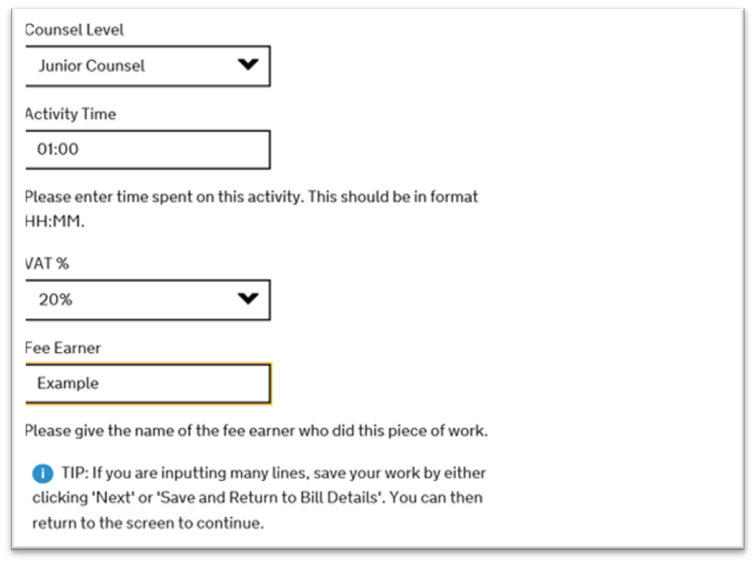
Once complete click Next and the Exclusions from Codified Rates screen will appear. Remove this screen if you have already completed the Codified Rates Screen previously.
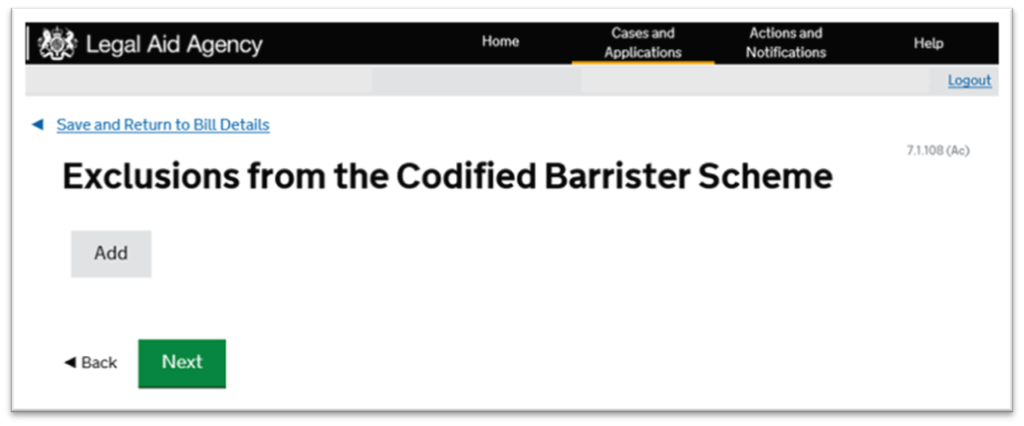
Step 6
Travel and waiting for counsel will be claimed on the next screen. Again, if using the ‘Exclusions from Codified Rates’, remove this screen and use the following screen.
Once completed you will have a chance to cross reference what CCMS has generated against what you had expected from your file. If required, you can request a copy of the breakdown by clicking on ‘Request Draft Print’ from the initial submission screen after clicking complete on the bill.
Evidence required on final bills
CCMS will generate an automatic document request once your final bill is created and you have clicked ‘Submit’
It will appear as a notification and will request evidence of disbursements, attendance notes, and counsel evidence.
Do not send your full file of papers unless a caseworker specifically requests it.
We only require certain evidence from the file which will be made clear in the notification.
Review the guidance on how to reply to the standard billing document request via CCMS.
Useful guidance links
Civil Finance Electronic Handbook – all current guidance for all things civil billing.
Costs Assessment Guidance (CAG) covers points to help with assessment and submission of bills.
LAA’s Training and Support Website contains all the current CCMS guidance on how to navigate and manage the system.
Queries
Should you have any billing related queries, please lodge a Billing Enquiry on the case in CCMS. See the Submitting an Enquiry on CCMS online guidance.